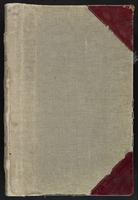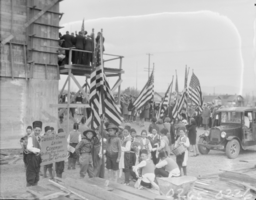Search the Special Collections and Archives Portal
Search Results
Diana Saunders oral history interviews
Identifier
Abstract
Oral history interviews with Diana Saunders conducted by Joyce (Marshall) Moore on May 23, 1996, conducted by Brigid Kelly on July 22, 2002, and conducted by Joanna Goodwin on August 12, 2002 for the Women's Research Institute of Nevada (WRIN) Las Vegas Women Oral History Project. In her interviews Saunders discusses her dance career in New York City, New York. Saunders discusses working on Broadway and touring internationally in Europe and Australia as a dancer. Saunders discusses working at the Dunes in Las Vegas, Nevada and her experiences as a dancer in Las Vegas. Saunders also talks about the lengths dancers had to go through to be successful.
Archival Collection

Las Vegas City Commission Minutes, June 22, 1911 to February 7, 1922
Date
Archival Collection
Description
Text

Film transparency of Las Vegas High School, Las Vegas, February 22, 1930
Date
Archival Collection
Description
Image
Andy Hafen oral history interview
Identifier
Abstract
Oral history interview with Andy Hafen conducted by Stefani Evans and Claytee D. White on August 22, 2016 for the Building Las Vegas Oral History Project. In this interview, Hafen discusses his upbringing in Henderson, Nevada. He recalls being elected to the City Council in 1987, the expansion of Henderson, and the development of the Water Street District. Hafen then talks about redevelopment of historic areas and the increase in businesses in Henderson. Later, Hafen discusses Lake Las Vegas, the drought and its effect on Lake Mead, and the challenges in developing Lake Las Vegas. Lastly, Hafen explains the how Nevada State College (NSC) has become the necessary link between the College of Southern Nevada (CSN) and the University of Nevada, Las Vegas (UNLV).
Archival Collection
Sherrill and Samuel Coleman oral history interviews
Identifier
Abstract
Oral history interviews with Sherril and Samuel Coleman conducted by Claytee White on February 12 and 22, 2016 for the African Americans in Las Vegas: a Collaborative Oral History Project. In these interviews, Sherrill and Samuel Coleman discuss experiencing violence against African Americans in Durant, Mississippi, and discuss moving to Las Vegas, Nevada during the 1990s. The Colemans later describe their contributions with the African American community and recall the poor working conditions for African Americans in Las Vegas and throughout the United States. The two then discuss social class, American Federation of Labor (AFL-CIO), and their involvement with religious organizations.
Archival Collection
Ivory H. Blue II oral history interview
Identifier
Abstract
Oral history interview with Ivory H. Blue II conducted by John Grygo on 2013 February 22 for the African Americans in Las Vegas: A Collaborative Oral History Project. This oral history documents the early life of Ivory H. Blue II in Las Vegas, Nevada while growing up in the Westside projects. He also discusses his college years in the 1990s at the University of Nevada, Las Vegas.
Archival Collection
Paul Velez oral history interview
Identifier
Abstract
Oral history interview with Paul Velez conducted by Barbara Tabach on February 22, 2018 for the Remembering 1 October Oral History Project. In this interview, Paul Velez, a University of Nevada, Las Vegas (UNLV) campus officer, discusses his experience at the Thomas & Mack Center during the night of the October 1, 2017 mass shooting in Las Vegas, Nevada. He shares his goal of creating a safe atmosphere for the survivors and providing them with all of their needs, including helping separated survivors find their loved ones and friends. Velez also describes his move to Las Vegas in 2008 and his time with the New York City police force, talking about his experience as a first responder at Ground Zero during the 9/11 attacks. He discusses the effect these attacks have had on general and campus security measures and on him as an individual.
Archival Collection

J. K. Russ oral history interview: transcript
Date
Archival Collection
Description
Oral history interview with J. K. Russ conducted by Claytee D. White on December 22, 2017 for the Remembering 1 October Oral History Project. In this interview, Russ discusses her early life in New Zealand and growing up on a tobacco farm. She remembers arriving to the United States and establishing a career as an artist. Russ talks about the 1 October shooting, creating an art exhibit using cards and letters received from people all over the world, and Las Vegas’ response to the tragedy. Lastly, Russ describes the art community in Las Vegas and the Arts District.
Text
Charlotte Ellsworth oral history interview
Identifier
Abstract
Oral history interview with Charlotte Ellsworth conducted by Jane Ellsworth Olive on March 22, 1977, December 26, 1980, December 28, 1981, and August 06, 1987 for the Ralph Roske Oral History Project on Early Las Vegas. In the span of four interviews, Ellsworth discusses her family’s history, the growth of Henderson, Nevada, working at the Basic Magnesium Plant, and life during World War II. She also talks about war bond drives, the Oakey Theaters, Nevada Chamber of Commerce, "western" clothes, and hotels like the Flamingo Hotel and the Riviera Hotel. She then describes visiting places like Canada, Salt Lake City, Utah, Washington, D. C., and San Francisco, California.
Archival Collection
Harry Mortenson oral history interviews
Identifier
Abstract
Oral history interviews with Harry Mortenson conducted by Claytee D. White on April 08, 2014, April 22, 2014, and May 06, 2014 for the Boyer Early Las Vegas Oral History Project. In the first interview, Mortenson discusses his personal background, working at Los Alamos National Laboratory in New Mexico, and arriving to Nevada to work as a nuclear physicist at the Nevada Test Site. Mortenson describes his work and recalls anecdotes from his employment. He then talks about his company, Sigma Scientific, and explains the different projects where he worked as a consultant. In the second interview, Mortenson discusses the methods of transportation used to arrive to the Nevada Test Site, his involvement with different organizations, and his tenure in the Nevada State Legislature. In the final interview, Mortenson discusses the device he built to take photographs of the nuclear reactor cores at Las Alamos National Laboratory, and explains how that device worked.
Archival Collection
